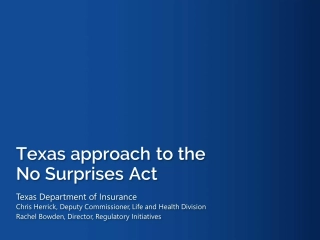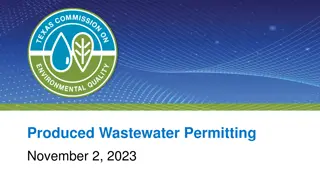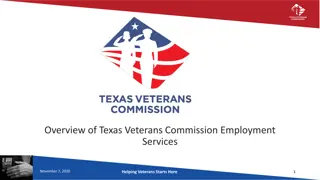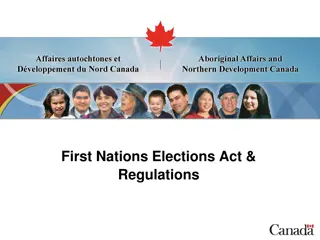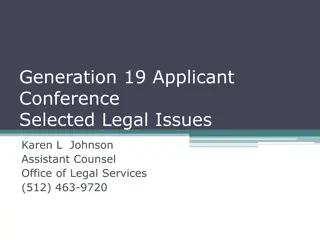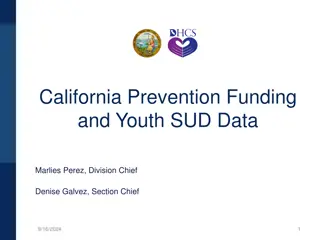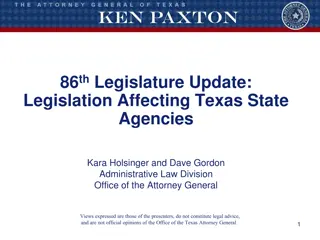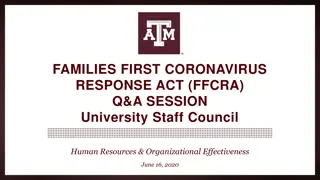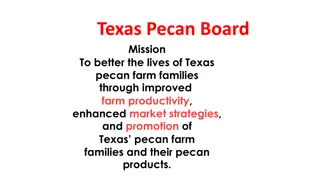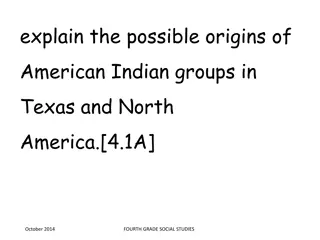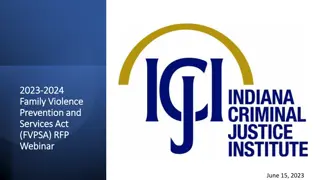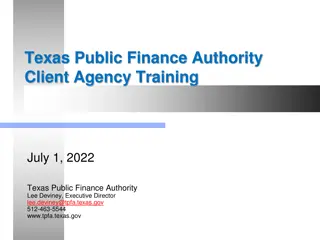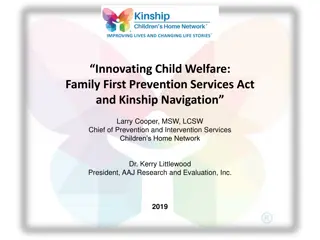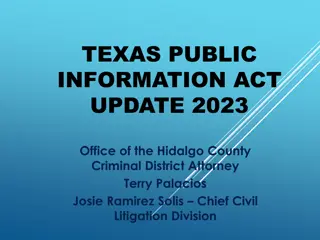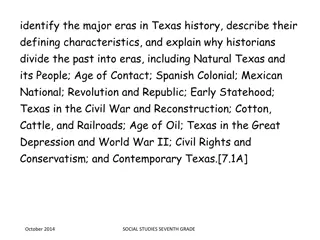Understanding the Family First Prevention Services Act (FFPSA) in Texas
The Family First Prevention Services Act (FFPSA) aims to improve outcomes for children in congregate care, kinship caregivers, parents struggling with substance abuse, and children at risk of entering foster care. FFPSA focuses on decreasing congregate care usage, preventing additional foster care entries, supporting kin placements, elevating prevention service quality, and allowing children to be placed in substance abuse treatment centers with their parents. Texas has delayed FFPSA implementation until September 2021, focusing on stakeholder engagement and strategic planning.
Download Presentation

Please find below an Image/Link to download the presentation.
The content on the website is provided AS IS for your information and personal use only. It may not be sold, licensed, or shared on other websites without obtaining consent from the author. Download presentation by click this link. If you encounter any issues during the download, it is possible that the publisher has removed the file from their server.
E N D
Presentation Transcript
Family First Prevention Services Act (FFPSA) The Changing Landscape of Texas
What is FFPSA? The Family First Prevention Services Act (FFPSA) passed in February 2018 FFPSA looks to improve service and outcomes for four main populations: Children placed in congregate care. Kinship caregivers and the children they care for. Parents who struggle with substance abuse and their children. Children who are at imminent risk for entering foster care. o Any time a child is the subject of a safety plan and absent preventive services the plan is removal. o A child is not the subject of a safety plan but is at high or very high risk of abuse or neglect, and absent preventive services the plan is removal. 2
What is FFPSA? FFPSA aims to: Decrease the use of congregate care settings. Prevent additional entries into foster care. Encourage and support kin placements. Elevate the quality of specific types of prevention services* provided to families with children at risk of entering foster care. Allow children to be placed with their parents in substance abuse treatment facilities. FFPSA establishes several new opportunities for states: Federal Title IV-E match for children placed in limited specialized settings for specific populations; Open-ended federal match for approved evidence-based prevention services; and Federal match for certain evidence-based, approved Kinship Navigator programs. 3 -*FFPSA references to prevention services do not mean the traditional Texas Prevention and Early Intervention services, but rather secondary prevention for children at imminent risk of entering the foster care system
Texas Decision In November 2018, Texas notified the Federal Administration for Families and Children (ACF) that it intended to delay implementation of FFPSA until September 2021. Texas is currently analyzing available information and has begun engagement of stakeholders. Texas is developing a strategic plan due September 1, 2020, to inform the Legislature about potential options for implementation. 4
Required FFPSA Provisions for States FFPSA included five required provisions to start FFPSA funding: Creation of an Interstate Compact on the Placement of Children (ICPC) National Electronic Interstate Compact Enterprise (NEICE) System (Required by 2027). Creation of a Statewide Fatality Prevention Plan, to Prevent Abuse and Neglect Fatalities. Establish Protocols to Prevent Inappropriate Diagnoses and Ensuring Appropriate Placements. Create Procedures for Providers to Conduct Abuse and Neglect Registry and Criminal Records Checks, Including Fingerprint-Based Checks. Compliance with Federal Model Licensing Standards. 5
New Funding for Prevention Activities Allows states to use federal matching funds for evidence based prevention and treatment services. Who: Children Texas determines are at imminent risk of placement in foster care AND their parents or kinship caregivers and pregnant and parenting foster youth with no financial edibility required. What: Eligible prevention services are mental health, substance abuse treatment and intensive in-home parenting skills building. How Long: Services are allowable for up to 12 months, with no limit on how many times a child and family can receive prevention services if the child continues to be at risk of entry into foster care. Due to new federal funds, new data requirements will also be enforced. 6
Eligible Services Services must meet well-supported, supported or promising ratings based on: studies done through a RCT or QED and have favorable effect on one FFPSA target outcome. There have been 12 programs reviewed. With 6 well-supported, 1 supported, 2 promising and then 3 that do not currently meet criteria. Healthy Families and Parents as Teachers are a couple of the current programs that have received a well supported service rating. Currently, 21 services are waiting for review, to include Nurturing Parenting. This was our FBSS pilot that has just completed a year of service. 7
Federal Matching Federal match will continue for these placements: Facility for pregnant and parenting youth. Supervised independent living for youth 18 years and older. Specialized placements for youth who are victims of or at-risk of becoming victims of sex trafficking. Foster Family Home no more than six children in foster care, with some exceptions, such as sibling placement. High quality and necessary congregate care QRTP. 8
Qualified Residential Treatment Program In order to get federal reimbursement requires: 30-day Independent child assessment 60-day stay requires approval by court Review every six months Trauma-informed treatment model Registered/licensed nurse or clinical staff consistent with treatment model Outreach and engagement of family in treatment plan Have a child discharge plan and provide at least 6 months of after care Licensed and accredited 9
Section Requirements Section 50711- Prevention Services 50712-Substance Abuse Services 50713-Kinship Navigator Program 50721-Family Reunification Services 50722-ICPC/NEICE System 50731-Model Licensing Standards: Foster Homes 50732-Fatality Prevention Plan 50733-Title IV-E Name Change 50741-QRTPs/Accreditation 50742-30-day Assessments 50743-Prevent Inappropriate Diagnoses 50744-Reporting Requirements 50745-Background Check Requirements 50751-Funding Supporting and Retaining Foster Families 50753-Chafee Funding 50771-Data Exchange Standards 50781-Delinking Adoption Assistance Eligibility Required/Optional Optional Optional Optional Additional Analysis Required, seeking grant opportunity Required, submitted to ACH Required, Likely in Compliance Additional Information Required Optional Optional Required, Likely in Compliance Additional Information Required Required, Pending Additional Information Required Optional, Additional Information Required Additional Information Required Additional Information Required 10
A Few Quick Facts Texas has a low removal rate, approximately 2.4 per 1,000 children in the population Texas has already been reducing the number of children in Congregate Care. Only 11% placed in congregate care in 2018. 5% decrease over the last 10 yrs. Kinship placements have also been on the rise. In Texas, over 40% of kids in substitute care are in a Kinship placement.
How has Texas supported the goals of FFPSA? Congregate Care Texas places more than 87% of children in the Texas Foster Care System in family-like settings. Expansion of Community Based Care (CBC). Treatment Foster Care (TFC) which recruits and trains professional foster parents to support children who might have traditionally needed residential treatment services in a family home setting. 12
How has Texas supported the goals of FFPSA? Kinship Supports Kinship caregivers have access to case management services provided by a kinship caseworker and, as a result of HB 4 (85R), a monetary stipend to help care for kids. Kin caregivers also have the option to become a verified foster home, allowing them to access additional services and supports, as well as a daily placement rate. Outside of child welfare, kin caregivers have access (when eligible) to additional services, such as SNAP, Medicaid, and TANF. 13
How has Texas supported the goals of FFPSA? Prevention Services Texas currently serves families at eminent risk of entering the foster care system through Family-Based Safety Services. Accesses free or low-cost services for parenting skills training and support. Utilizes Purchase Client Service dollars and HHSC programs for mental health and substance abuse. SB 11 (85R) established a pilot for FBSS case management. The pilot is required to use evidence-based services, be trauma-informed, and demonstrate improved outcomes for the families they serve. The El Paso FBSS pilot with Pathways has been serving families since June 2018. 14
State Legislation and Planning Texas will use the 86th Interim to study the implementation options and potential costs for FFPSA and inform the 87th Legislature of options for the state. SB 355 requires DFPS to submit a strategic plan for implementation of the prevention services provisions of FFPSA SB 781 requires DFPS to submit an analysis and recommendations associated with the placement provisions of FFPSA These two strategic plans will be combined and completed by September of 2020. 15
What is Texas doing to prepare for FFPSA? Texas will: Determine the efficacy of the approved, evidence-based prevention programs. Examine costs and outcomes for serving children in approved congregate care settings. Determine the benefits of provider accreditation, and effects on child welfare outcomes. Consider the continued decline in the percentage of children eligible for Title IV-E as costs and benefits are analyzed. 16
What is Texas doing to prepare for FFPSA? Texas will: Research current practices and guidelines for service referral. Use partners to assist with service development and evaluation of services eligible for FFPSA. Develop work group with SSCC and FBSS contractors. Perform cost/benefit analysis. Analyze the effort associated with evaluation of prevention program. Identify data elements associated with FFPSA required reporting and analyze effort needed to comply. 17
What is Texas doing to prepare for FFPSA? Texas will: Research outcomes, impact on costs and workload to implement QRTP s. Identify Kinship navigator programs supported by FFPSA. Evaluate allocation of money, loss of IV-E dollars and potential effects of implementing FFPSA. Identify costs for training. 18
Work Underway U of H completed kinship navigator study. DFPS and HHSC are partnering on next steps. Work with Casey Family Programs and Texas Center for Child and Family Studies to survey current landscape of prevention services. Application for NEICE grant. Stakeholder engagement through existing workgroups has started. 19
Work Underway Stakeholder Engagement Strategy Action Plan Engaging with other states and federal government Consider outcomes in other states that have implemented like programs 20
Visit our website & sign up for updates dfps.state.tx.us/Child_Protection/Family_First/default.asp 21
Questions Questions? 22


